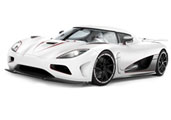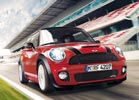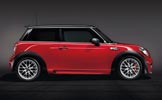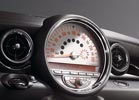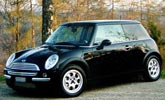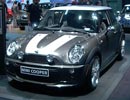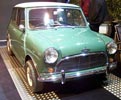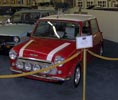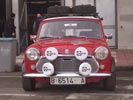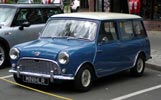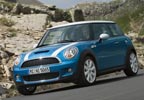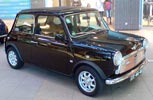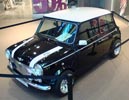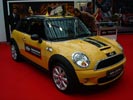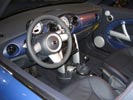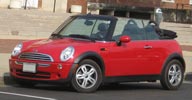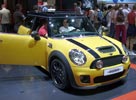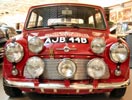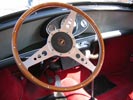The Mini is a small car that was produced by the British Motor Corporation (BMC) and its successors from 1959 until 2000. The most popular British-made car ever, it was superseded by the New MINI, which was launched in April 2001. The original is considered an icon of the 1960s, and its space-saving front-wheel-drive layout (that allowed 80% of the area of the car's floorpan to be used for passengers and luggage) influenced a generation of car-makers. The vehicle is in some ways considered the British equivalent to its German contemporary, the Volkswagen Beetle, which enjoyed similar popularity in North America.
The Mini Cooper and Cooper S: 1961-2000
John Cooper, owner of the Cooper Car Company and designer and builder of Formula 1 and rally cars, saw the potential of the Mini for competition. Issigonis was initially reluctant to see the Mini in the role of a performance car, but after John Cooper appealed to BMC management, the two men collaborated to create the Mini Cooper, a nimble, economical and inexpensive car. The Austin Mini Cooper and Morris Mini Cooper debuted in 1961.
The original 848 cc engine from the Morris Mini-Minor was increased to 997 cc, boosting power from 34 bhp to 55 bhp (25 to 41 kW). [9] The Mini Cooper car featured a racing-tuned engine, twin SU carburettors, a closer-ratio gearbox and front disc brakes, uncommon at the time in a small car. One thousand Mini Cooper of this version were commissioned by management, intended for and designed to meet the homologation rules of Group 2 rally racing. The 997 cc engine was replaced by a shorter stroke 998 cc unit in 1964.
A more powerful Mini Cooper, dubbed the "S", was developed in tandem and released in 1963. Featuring a 1071 cc engine and larger servo-assisted disc brakes, 4,030 Mini Cooper S cars were produced and sold until the model was updated in August 1964. Cooper also produced two models specifically for circuit racing, rated at 970 cc and a 1275 cc, both of which were also offered to the public. The smaller-engine model was not well received, and only 963 had been built when the model was discontinued in 1965. The 1275 cc Mini Cooper S models continued in production until 1971.
Sales of the Mini Cooper were as follows: 64,000 Mark I Coopers with 997 or 998 cc engines; 19,000 Mark I Cooper S with 970, 1071 or 1275 cc engines; 16,000 Mark II Coopers with 998 cc engines; 6,300 Mark II Cooper S with 1275 cc engines. There were no Mark III Mini Cooper and just 1,570 Mark III Mini Cooper S's.
The Mini Cooper S earned acclaim with Monte Carlo Rally victories in 1964, 1965 and 1967. Minis were initially placed first, second and third in the 1966 rally as well, but were disqualified after a controversial decision by the French judges. The disqualification related to the use of a variable resistance headlamp dimming circuit in place of a dual-filament lamp. It should be noted that the CitroŽn DS that was eventually awarded first place had illegal white headlamps but escaped disqualification. The driver of the CitroŽn, Pauli Toivonen, was reluctant to accept the trophy and vowed that he would never race for CitroŽn again. BMC probably received more publicity from the disqualification than they would have gained from a victory but had the Mini not been disqualified, it would have been the only car in history to be placed in the top three on the Monte Carlo for six consecutive years.
In 1971, the Mini Cooper design was licensed in Italy by Innocenti and in 1973 to Spain by Authi (Automoviles de Turismo Hispano-Ingleses), which began to produce the Innocenti Mini Cooper 1300 and the Authi Mini Cooper 1300, respectively.
A new Mini Cooper named the RSP (Rover Special Products) was briefly relaunched in 1990-91, with slightly lower performance than the 1960s Cooper. It proved so popular that the new Cooper-marked Mini went into full production in late 1991. From 1992, Coopers were fitted with a fuel-injected version of the 1275 cc engine, and in 1997 a multi-point fuel injected engine was introduced, along with a front-mounted radiator and various safety improvements.
In 1971, the 1275 cc Mini Cooper S was discontinued in the UK, leaving the Mini 1275GT as the only sporting Mini on sale for the rest of the decade. Innocenti in Italy, however, continued making their own version of the Mini Cooper for some time, and In Australia from mid 1971 to the end of 1972, the Clubman GT was locally produced. This was essentially a Cooper S in Clubman body, equipped with the same 7 1/2" disc brakes, twin fuel tanks, and twin-carb Cooper S 1275 cc engine. While the UK built 1275GT was not nearly as quick as a 1275 Mini Cooper S, it was cheaper to buy, run, and insure. It was the first Mini to be equipped with a tachometer. It also featured a standard-fit close-ratio gearbox. Performance of the 1275GT was lively for the time, achieving 0-60 mph in 12.9 seconds, and the excellent midrange torque offered a 30-50 mph time in top gear of only nine seconds. The bluff front, however, meant that the model struggled to reach 90 mph (140 km/h). The 1275 cc A-series engine could be cheaply and easily tuned, though the cheap purchase price and prominent "sidewinder" door stripes meant that this model developed a reputation as something of a "boy-racer special" during the '70s and into the '80s.
The Mini Clubman and 1275GT were responsible for two motoring "firsts": they were the first vehicles to use a flexi printed-circuit board behind the dash instruments (universal nowadays, but technically advanced for 1969). Secondly, the 1275GT was the first vehicle to be offered with run-flat tyres; from 1974 this model could be ordered with optional Dunlop Denovo tyres on 12-inch (300 mm) diameter rims. In the event of a puncture, the Dunlop Denovo tyre would not burst and quickly deflate, but could continue to be used safely at speeds of up to 50 mph (80 km/h). This was a useful safety feature, although the increased road noise and relatively poor grip of this tyre meant that many 1275GT buyers ignored this option.
Throughout the 1970s, British Leyland continued to produce the classic 1959 "round-front" design, alongside the newer Clubman and 1275GT models. On the Australian market however, all Minis (including the commercial derivatives) gained the Clubman front.
The long-nose Clubman and 1275GT offered better crash safety, were better equipped, and had vastly better under-bonnet access, but they were more expensive and aerodynamically inferior to the original 1959 design. The Mini Clubman and 1275GT were replaced in 1980 by the new hatchback Austin Metro, while production of the original "round-front" mini design continued for another 20 years. At the end of Clubman and 1275GT production, 275,583 Clubman saloons, 197,606 Clubman Estates and 110,673 1275GTs had been made.
Car - Mini Cooper
Copyright © 1998-2013 you.com.au

